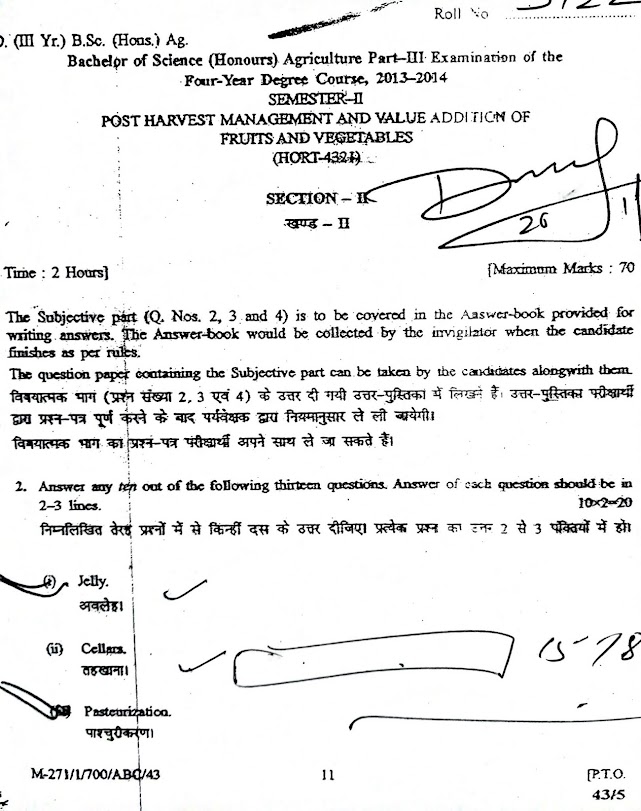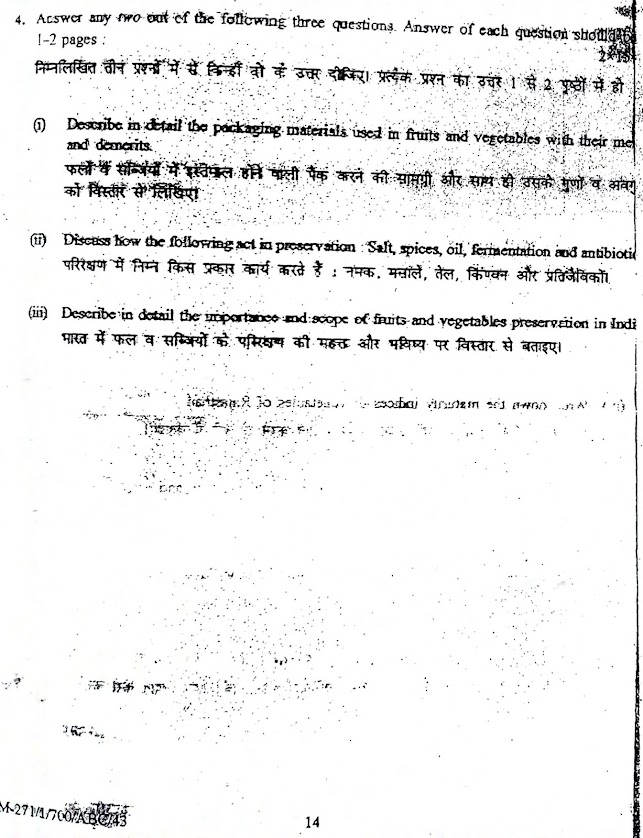2013 - 14 Solved Old Paper (HORT - 4321) OK
SECTION - I
Fill in the Blank Type Questions:-
Q.1. Respiration is a _______ process that releases energy in the form of ATP.
श्वसन एक _______ प्रक्रिया है जो एटीपी के रूप में ऊर्जा छोड़ती है।
Answer: biochemical / जैव रासायनिक
Q.2. External respiration involves the exchange of gases between the organism and the _______.
बाहरी श्वसन में जीव और _______ के बीच गैसों का आदान-प्रदान शामिल होता है।
Answer: external environment / बाहरी वातावरण
Q.3. Aerobic respiration occurs in the presence of _______.
एरोबिक श्वसन _______ की उपस्थिति में होता है।
Answer: oxygen / ऑक्सीजन
Q.4. The chemical equation for aerobic respiration includes glucose, oxygen, carbon dioxide, water, and _______ ATP.
एरोबिक श्वसन का रासायनिक समीकरण ग्लूकोज, ऑक्सीजन, कार्बन डाइऑक्साइड, पानी और _______ एटीपी को शामिल करता है।
Answer: 38
Q.5. Anaerobic respiration produces _______ ATP per glucose molecule.
अवायवीय श्वसन प्रति ग्लूकोज अणु _______ एटीपी उत्पन्न करता है।
Answer: 2
Q.6. In yeast, anaerobic respiration produces ethanol and _______.
खमीर में, अवायवीय श्वसन इथेनॉल और _______ उत्पन्न करता है।
Answer: carbon dioxide / कार्बन डाइऑक्साइड
Q.7. In muscle cells, anaerobic respiration leads to the production of _______.
मांसपेशी कोशिकाओं में, अवायवीय श्वसन _______ के उत्पादन की ओर ले जाता है।
Answer: lactic acid / लैक्टिक एसिड
Q.8. Enzyme activity generally increases with temperature up to _______°C.
एंजाइम सक्रियता सामान्यतः _______°C तक तापमान बढ़ने के साथ बढ़ती है।
Answer: 35-40
Q.9. Beyond optimum temperature, enzymes may _______ and reduce respiration rate.
इष्टतम तापमान से परे, एंजाइम _______ हो सकते हैं और श्वसन दर घट सकती है।
Answer: denature / विकृत
Q.10. Oxygen availability affects the _______ in aerobic respiration.
ऑक्सीजन की उपलब्धता एरोबिक श्वसन में _______ को प्रभावित करती है।
Answer: electron transport chain / इलेक्ट्रॉन परिवहन श्रृंखला
Q.11. In plants, high CO₂ levels may initially _______ respiration but inhibit it over time.
पौधों में, उच्च CO₂ स्तर प्रारंभ में श्वसन को _______ कर सकते हैं लेकिन समय के साथ इसे अवरुद्ध कर सकते हैं।
Answer: stimulate / उत्तेजित
Q.12. Dehydration can _______ the respiration rate due to lack of water.
निर्जलीकरण जल की कमी के कारण श्वसन दर को _______ कर सकता है।
Answer: reduce / घटा सकता है
Q.13. Substrate availability such as _______ is crucial for maintaining respiration.
_______ जैसे सब्सट्रेट की उपलब्धता श्वसन को बनाए रखने के लिए महत्वपूर्ण है।
Answer: glucose / ग्लूकोज
Q.14. pH levels around _______ are optimal for enzyme activity in humans.
मनुष्यों में एंजाइम सक्रियता के लिए pH स्तर _______ के आसपास इष्टतम है।
Answer: 7.4
Q.15. Light intensity affects plant respiration by influencing _______ availability.
प्रकाश की तीव्रता पौधों के श्वसन को _______ की उपलब्धता को प्रभावित करके प्रभावित करती है।
Answer: glucose / ग्लूकोज
MCQs Type Questions:-
Q.1. What is the primary purpose of respiration? / श्वसन का मुख्य उद्देश्य क्या है?
A. To produce oxygen / ऑक्सीजन उत्पन्न करने के लिए
B. To produce ATP / ATP उत्पन्न करने के लिए
C. To produce glucose / ग्लूकोज उत्पन्न करने के लिए
D. To produce carbon dioxide / कार्बन डाइऑक्साइड उत्पन्न करने के लिए
Q.2. Which stage of respiration involves the exchange of gases? / श्वसन का कौन सा चरण गैसों के आदान-प्रदान से संबंधित है?
A. Internal respiration / आंतरिक श्वसन
B. External respiration / बाह्य श्वसन
C. Anaerobic respiration / अवायवीय श्वसन
D. Glycolysis / ग्लाइकोलाइसिस
Q.3. What is the end product of anaerobic respiration in muscle cells? / मांसपेशी कोशिकाओं में अवायवीय श्वसन का अंतिम उत्पाद क्या है?
A. Ethanol / एथेनॉल
B. Lactic acid / लैक्टिक अम्ल
C. Carbon dioxide / कार्बन डाइऑक्साइड
D. Water / पानी
Q.4. Which factor directly affects enzyme activity during respiration? / कौन सा कारक श्वसन के दौरान एंजाइम गतिविधि को सीधे प्रभावित करता है?
A. Temperature / तापमान
B. Light / प्रकाश
C. Pressure / दबाव
D. Salinity / लवणता
Q.5. How many ATP molecules are produced in aerobic respiration? / ऐरोबिक श्वसन में कितने ATP अणु उत्पन्न होते हैं?
A. 2
B. 4
C. 38
D. 24
Q.6. What happens to enzymes when the temperature exceeds the optimum level? / जब तापमान इष्टतम स्तर से अधिक हो जाता है तो एंजाइम का क्या होता है?
A. They function faster / वे तेजी से कार्य करते हैं
B. They denature / वे संरचना खो देते हैं
C. They multiply / वे गुणा करते हैं
D. No effect / कोई प्रभाव नहीं
Q.7. In plants, how does increased CO₂ concentration initially affect respiration? / पौधों में, प्रारंभ में CO₂ सांद्रता बढ़ने से श्वसन पर क्या प्रभाव पड़ता है?
A. Decreases / घटता है
B. Increases / बढ़ता है
C. No effect / कोई प्रभाव नहीं
D. Stops completely / पूरी तरह बंद हो जाता है
Q.8. What is the chemical formula for glucose? / ग्लूकोज का रासायनिक सूत्र क्या है?
A. C₆H₁₂O₆
B. CO₂
C. H₂O
D. C₂H₅OH
Q.9. Which enzyme is involved in glycolysis? / ग्लाइकोलाइसिस में कौन सा एंजाइम शामिल होता है?
A. Hexokinase / हेक्सोकाइनेज़
B. Cytochrome oxidase / साइटोक्रोम ऑक्सीडेज़
C. Catalase / कैटालेज़
D. Amylase / ऐमाइलेज
Q.10. What is the effect of dehydration on respiration? / निर्जलीकरण का श्वसन पर क्या प्रभाव पड़ता है?
A. Increases respiration rate / श्वसन दर बढ़ती है
B. Decreases respiration rate / श्वसन दर घटती है
C. No effect / कोई प्रभाव नहीं
D. Completely stops respiration / श्वसन पूरी तरह बंद हो जाता है
Q.11. Which stage of respiration is affected by low oxygen levels? / निम्न ऑक्सीजन स्तर से श्वसन का कौन सा चरण प्रभावित होता है?
A. Krebs cycle / क्रेब्स चक्र
B. Glycolysis / ग्लाइकोलाइसिस
C. Electron transport chain / इलेक्ट्रॉन परिवहन श्रृंखला
D. Fermentation / किण्वन
Q.12. What is the pH range for optimal enzyme activity in humans? / मनुष्यों में इष्टतम एंजाइम गतिविधि के लिए pH सीमा क्या है?
A. 6.0 - 6.5
B. 7.0 - 7.4
C. 8.0 - 8.5
D. 5.0 - 5.5
Q.13. Which of the following is not a product of aerobic respiration? / निम्नलिखित में से कौन सा ऐरोबिक श्वसन का उत्पाद नहीं है?
A. Water / पानी
B. Carbon dioxide / कार्बन डाइऑक्साइड
C. Ethanol / एथेनॉल
D. ATP / ATP
Q.14. What happens to glucose in anaerobic respiration in yeast? / यीस्ट में अवायवीय श्वसन में ग्लूकोज का क्या होता है?
A. Converts to lactic acid / लैक्टिक अम्ल में परिवर्तित होता है
B. Converts to ethanol and CO₂ / एथेनॉल और CO₂ में परिवर्तित होता है
C. Remains unchanged / अपरिवर्तित रहता है
D. Converts to ATP only / केवल ATP में परिवर्तित होता है
Q.15. What is the role of light in plant respiration? / पौधों के श्वसन में प्रकाश की भूमिका क्या है?
A. Directly involved in respiration / सीधे श्वसन में शामिल होता है
B. Increases glucose production / ग्लूकोज उत्पादन बढ़ाता है
C. Reduces oxygen demand / ऑक्सीजन की मांग घटाता है
D. Has no effect / कोई प्रभाव नहीं

2 MARKS QUESTIONS
English
Hindi


